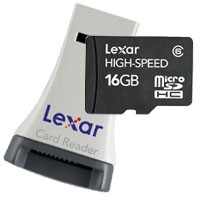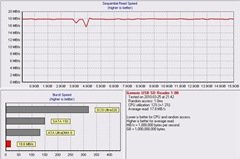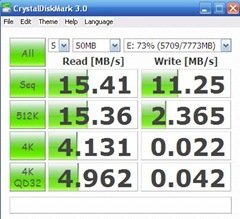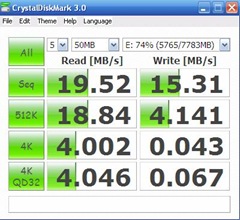I’ve always been impressed by those high-speed memory cards, offering speedy transfer rates of several MB/s over the standard vanilla cards. The advantages are clear in multi-megapixel digital SLRs and even compact digital cameras that are now capable of HD video capture. But how would these fair in the mobile environment? Are there any benefits when compared to slower Class 2 and 4 cards? One would certainly think so, especially since 8+ Megapixels, HD video capture and multi-Gigabytes of media is quickly becoming the norm. Enter Lexar’s High-Speed Mobile microSDHC Class 6 cards, with both 8 and 16GB flavors and includes their Mobile USB Card Reader. Let’s find out as we review Lexar’s speediest solution.
The SD association defines three levels of Speed Class: 2, 4 and 6. Interestingly these Class levels reveal a card’s minimum transfer and not the usual maximum speed: “Speed Class 2 guarantees a minimum transfer speed of 2 mega bytes per second (MB/s), Speed Class 4 guarantees a minimum transfer speed of 4 MB/s and Speed Class 6 guarantees a minimum transfer speed of 6 MB/s.”
Armed with Nokia’s flagship N900, we decided to put the Lexar’s 8GB Class 6 card against an 8GB Class 4 and a 16GB Class 2 Sandisk cards.
Lexar 8GB Class 6 microSDHC
Lexar’s Class 6 cards obviously look no different from other microSDHC cards. The small “6” printed on the card is about the only indication of the card’s speedy intentions.
The card does come with a handy card reader, something that is quickly becoming the norm with these high-end premium cards. Not only can it double as a convenient and very tiny USB thumb drive, but it also helps with the not-so-speedy transfer rate of smartphones when connected to your PC via USB. While their USB transfer rate has increased in the past years, it’s pretty rare to see anything above the 10Mb/s when smartphones are concerned. This where these card readers come in. They have a much speedier USB interface and can easily achieve speeds way above the the 10Mb/s mark, allowing for nearly triple to quadruple the speeds that can be achieved with most smartphones.
Lexar also includes a media management program called mediamove. The program is included on the card in a hidden file of about 90MB, but will be removed once the card is formatted. If you do have the need to format the card, I would suggest go into options and enabling hidden files and just making a backup copy, as the program doesn’t seem to available for download on the Lexar site. Its not a must, as its functionality can be achieved with other popular or preloaded Windows programs. It does simplify the process and the interface is very straightforward, allowing you to copy, sync and even upload media to popular online services like Youtube. We also liked the fact that it’s easy on our system’s resources. Should easily be netbook friendly.
How fast is the card?
HD Tach
During our testing we used the Lexar 8GB Class 6, Sandisk 8GB Class 4 and Sandisk 16GB Class 2.
Using HD Tach we got the following numbers.
| Card | Average Read speed (MB/s) | Burst Speed (MB/s) |
| Lexar 8GB Class 6 | 14.5 | 15 |
| Sandisk 8GB Class 4 | 17.8 | 18.9 |
| Sandisk 16GB Class 2 | 17.8 | 18.6 |
Both Sandisk cards prove to be a bit faster than the Lexar Class 6, with results very similar to HD Tach.
| Card | Seq Read (MB/s) | Seq Write(MB/s) |
| Lexar 8GB Class 6 | 15.4 | 11.25 |
| Sandisk 8GB Class 4 | 19.52 | 15.32 |
| Sandisk 16GB Class 2 | 19.31 | 13.45 |
Real World Test
Our real world test consisted of copying 5.8GB of MP3 files to the memory cards.
| Card | Minutes (Lower is better) |
| Lexar 8GB Class 6 | 23 |
| Sandisk 8GB Class 4 | 23.25 |
| Sandisk 16GB Class 2 | 39 |
Even though both Sandisk cards were able to outperform the Lexar card in both benchmarks, the Lexar pushes ahead in our real world test. Copying large files using the Nokia N900 from phone memory to Lexar card went significantly faster when compared to the Sandisk Class 2, but overall performance was similar to the Sandisk Class 4 card, but overall responsiveness was unaffected.
Conclusion
As our tests revealed, having a Class 6 rated card merely guarantees a minimum speed, but doesn’t say anything about the maximum or average speeds. As a Class 6 card, Lexar’s High-Speed Mobile microSDHC cards are speedy and easily surpass the minimum transfer speed of 6 MB/s. It should also exceed the performance of any modern (smart)phone currentlyon the market. The included card reader is handy and should offer performance that’s faster than any smartphone connected via USB. We were surprised that both Class 2 and 4 Sandisk cards were able to outperform the Lexar Class 6 card. But most importantly in our real world test, Lexar manages to push significantly ahead of the Class 2 card and just slightly ahead of the Class 4. Lexar’s Class 6 cards should be perfect for those that want to quickly and frequently transfer large amounts of files to and from your PC. Our tests have shown that it does, speed the copying of files on smartphones, but but overall speed and responsiveness of our test N900 was unaffected. The mediamove software is handy and very straight forward and we loved that it went easy on our systems resources. The Lexar gets a 7.9 out of 10.










